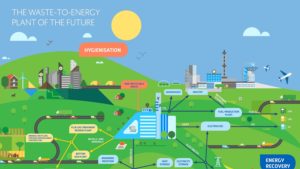ESWET: Vision for Waste-to-Energy 2050

Following the World Bank’s predictions that waste generation will increase by 60 % worldwide by 2050 and Eurostat’s figures which show that 24% of municipal waste is still landfilled today in Europe, there is a need to roll out globally sound waste management technologies including Waste-to-Energy to improve recycling and recovery and reduce dumpsites.
ESWET’s Vision demonstrates how Waste-to-Energy technologies from European suppliers are ready to contribute to low-carbon energy systems and circular societies in the EU and on a global scale. In fact, Waste-to-Energy plants will take care of the fraction of waste that cannot be directly recycled, preventing it from being landfilled and thus saving huge amount of greenhouse gas emissions. Moreover, the delivery of alternative fuels, such as hydrogen, from Waste-to-Energy plants will enable industry and transport sectors to further decarbonise.
From households to industries, shopping centers and greenhouses, the amount of facilities heated and cooled by the energy recovered from waste will constantly grow. Similarly, the roads we walk along and the buildings we live in will be more and more made of secondary raw materials from the plants’ ashes.
Waste-to-Energy plants will be increasingly integrated into the urban fabric and will generate multiple opportunities for citizens, while safeguarding the environment. Their large scale will allow to integrate sport centers (such as ski slopes, rock climbing gyms, skate parks, tennis courts, outdoor swimming pools, etc.) and edutainment activities to raise citizens’ awareness of waste management.
The ESWET Vision 2050 has been officially launched on Tuesday 24 September in Brussels in front of almost 150 people from the waste management and energy sector as well as the European Parliament, European Commission and Member States permanent representations. The event has been hosted jointly with ESWET’s sister association CEWEP, the Confederation of European Waste-to-Energy plants, which launched its sustainability roadmap towards a circular economy in 2035.
“Our industry has made giant leaps towards sustainability in the past decades”, ESWET President Edmund Fleck said. “We see a bright future for Waste-to-Energy, where all by-products of our industry will be sent back to the economy, in a low-carbon, circular way”, he added. “We need policy support for that future to become reality and such policies must ensure that basic waste management principles such as the waste hierarchy are safeguarded and a low carbon and clean circular economy emerges.” Mr Fleck continued. “Sound planning of waste treatment capacity is key to establish Waste-to-Energy as a sustainable waste management option anywhere”, he concluded.